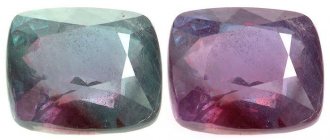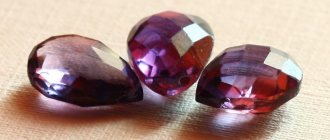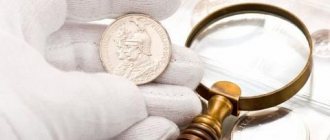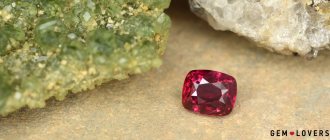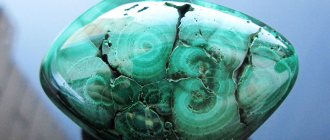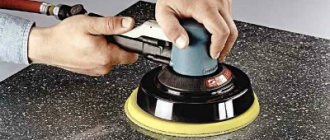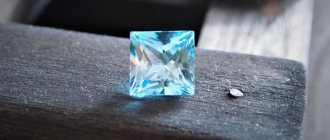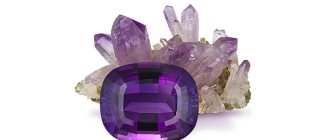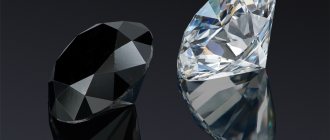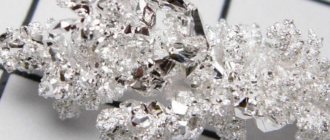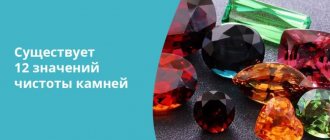What does a real diamond look like?
Many people are interested in what a diamond looks like. Real crystals have the following characteristics:
- Faceted stone. If it does not have a frame, it must be accompanied by a certificate that confirms its quality. If the stone is in the product, there is a br mark on the label. Clarity, carat, and cut type should also be assessed. In addition, the stone may be accompanied by an inclusion map.
- The presence of shimmer and shine. The stone sparkles and shimmers in the light. This helps to recognize a real gem. The word brillant is translated from French as “brilliant”.
- The presence of an invisible cut. If the stone is in jewelry, you cannot see its corners and top.
- Availability of different shades of grey.
- Reliable fixation in the product.
- Frame in gold or platinum.
- Hole under a stone. The bottom of the diamond should not touch the metal tightly. Refraction is related to the stone-air parameter.
What to consider when choosing a stone
The sparkling splendor of the showcase will easily make you lose your head. To prevent this from happening, you should only consider diamond products at affordable prices:
- Compare three to five copies of comparable quality and type.
- Choose a product with the best price-quality ratio.
- Analyze the certificate of authenticity. If it is not there, there is nothing to talk about. A document issued by a store is not a guarantee.
- Crystals with indicators of 1/1 (or similar) in purity and color should be chosen only as an independent object.
- Cheaper pieces are used for diamond jewelry: the setting will hide minor defects and visually change the shade.
A ring with a carat diamond is much more expensive than a similar one with several crystals of the same total mass.
Basic properties of the stone
After cutting, grinding and polishing, the diamond turns into a luxurious diamond. A real stone has the following properties:
- High degree of hardness. The gem is capable of withstanding pressure of several tons. It cannot be scratched. Only another diamond can leave a mark on a stone. The hardness parameters of the product are 10/10 in accordance with the Mohs scale.
- Fragility. This gem does not tolerate high shock loads. If you hit a diamond with a hammer, it will break like glass.
- High refractive parameters. When light hits a diamond, it sparkles with many silvery sparkles. Strong refraction prevents it from shimmering with colored highlights. It rather glows nobly in gray tones.
- Dispersion. This mineral has the most pronounced shine.
- Luminescence. When exposed to ultraviolet light, the crystal acquires a soft blue glow.
- Resistance to acids. The exception is fluorescent.
- Resistance to elevated temperatures. The stone can only burn when heated to 850 degrees.
- Color stability. Even after 100 years, a real stone will shine.
Difference between diamond and cubic zirconia
Despite their external similarity, a real diamond and cubic zirconia have differences:
- Origin. Diamond is natural, and zirconium is an artificial mineral.
- Character of radiance. The gemstone sparkles brighter and stronger than its synthetic counterpart.
- Shade of glow. The “King of Stones” scatters a silvery glow. It shimmers with shades of gray. Cubic zirconia shines with all the colors of the rainbow. But low-quality diamonds also give such shine.
- Weight. Zircon is half the weight of the gemstone.
- Optical properties. Diamond is opaque. Light passing through the upper smooth surface of the stone is reflected from the edges of the lower part. Looking at it from above, you will only see the iridescence and a small dot in the center (spike). All objects located behind it are visible through zirconium.
- Sharp edges and a rough matte girdle (the band between the crown and the pavilion) are signs of a diamond. Cubic zirconia has opposite characteristics.
- Price. A precious mineral cannot have a low price. Even if its weight is less than a carat, you will have to pay a hefty sum when purchasing it. If you are offered to sell a diamond whose price is significantly lower than the current market value, this is a scam. A cut diamond will never be cheap.
To verify the authenticity of stones, jewelers use special equipment - testers , which examine the thermal conductivity of materials and the refractive indices of light.
The most accurate result is obtained by using several devices, but they can also make mistakes.
What can it be easily confused with?
When purchasing, it is important to check the authenticity of the stone. Thanks to the use of modern technologies, artificial gems have appeared that cannot be distinguished from real ones. Moreover, they are made so well that even testers cannot identify a glass diamond.
The characteristics of the gemstone fully imitate the following fakes:
- Cubic zirconia – it is also called zircon. It is a synthetic stone. The mineral was invented by Soviet physicists. This happened in the seventies of the 20th century. Since then, cubic zirconia has become widespread throughout the world. It can be transparent or colored. Today there are gems of 6 shades.
- Moissanite is considered the most accurate copy. It looks 90% like a jewel and even shines more intensely. It is impossible to recognize moissanite with the naked eye. Even an experienced specialist can make a mistake.
- Rock crystal - resembles a diamond in appearance. If you cut this mineral, it will acquire an intense shine. At the same time, it is combined with silver and sometimes with gold. For cutting diamonds, only platinum and gold settings are used. You can fix the crystal with glue. This type of coating is not usually used when working with diamonds.
In addition, it is important to distinguish a processed diamond from the following gems:
- leucosapphire;
- artificial diamond;
- white beryl;
- combination of synthesized stones;
- white topaz;
- rhinestones.
HOW TO DECODE A TAG
The tags indicate the weight of adamant, its shade, transparency, shape and type of cut, the presence of inclusions, and shine.
So, if the tag says “5Br-P49–5.5ct–2/3B”, this means:
- “5Br” - there are 5 adamants in the jewelry;
- “P49” is a cut. Each of the 5 diamonds has 49 facets and is cut into a Princess (P) cut.
- “5.5ct” is the sum of the mass of 5 stones;
- “2/3”, 2 – color, 3 – purity (according to the International VVS2 scale);
- “B” is the type of cut, that is, deep cut.
When purchasing a ring, you need to examine it from the inside. If the stamp says PT (Plat), which means “platinum,” you can be sure that this is a real diamond, since zirconium is never combined with platinum.
The letters CZ mean it is zirconium.
Professional authentication methods
Many people are interested in how to identify a diamond. There are quite a few ways to test a stone and identify a fake.
Light
Light will help determine the quality of a gem. To do this, you need to bring it to a light source that is at hand, and pay attention to the appearance of the beam. If it forms a small point or is evenly distributed around the perimeter, the stone is real.
Comparison
When answering the question of how to distinguish a diamond from a fake, you should pay attention to the following features:
- Real diamonds are mined from nature. It cannot be perfectly clean. If you examine a stone with a magnifying glass, you will be able to see all the defects in it. A perfectly smooth and even texture indicates the artificial origin of the decoration.
- A cut diamond shimmers very strongly. The rest of the gems look pale and expressionless against its background. At the same time, it is difficult to distinguish natural gems from fake ones based on this parameter. Some fake minerals sparkle as much as diamonds.
- Diamonds are characterized by a high degree of strength. After processing, the edges become clearer. Glass products have less sharp and slightly rounded edges.
Distortion
The originality of a diamond can be checked by the nature of its refraction. By directing light at it and examining it through a magnifying glass, you will be able to see the reflection of the direct light beam from the edges. It doesn't split or deviate. This sign is characteristic of cubic zirconia.
What is cubic zirconia
A diamond is status, beautiful and expensive. Everyone dreams of wearing jewelry with such a stone, but only wealthy people can buy it. To satisfy consumer demand, scientists have found an artificial replacement for the precious stone - cubic zirconia. It was created in the USSR in 1970. In Western countries it is called zirconium.
Cubic zirconia is a popular, sought after and cheap substitute for diamond. It does not occur in nature. This is a synthetic material - crystallized zirconium dioxide.
Its manufacturing technology includes five stages:
- Zirconium oxide powder is poured into a special container and melted.
- The outer layer must remain at room temperature, so it is constantly cooled with water circulating through the tubes.
- When the inner layer is melted, it is left to cool to room temperature.
- Cylindrical blanks measuring 2 by 2 cm are removed from the core.
- Artificial crystals are then grown. This happens quickly - in an hour they increase by 9 cm.
Initially, only transparent cubic zirconia was obtained. Modern technologies make it possible to create stones of seven colors. To give the required shade, a base of cobalt, titanium, chromium and other rare earth elements is added to the raw material.
Weight
To determine the authenticity of products, you can weigh them on carat scales. This method is based on the fact that the size of the jewelry must correspond to the carat weight. One carat corresponds to 0.2 g. Moreover, zircons are 2 times heavier compared to diamonds. Therefore, identifying a fake will not be difficult.
Frame
Jewelers treat the production of diamond jewelry very carefully. With the help of the frame it is possible to disguise small defects and other inclusions. The finished product should look high quality. At the same time, the metal, frame and fastening buttons help to distinguish a real product from a budget one.
A step-by-step check of the decoration looks like this:
- Pure diamonds are usually set in platinum or white gold. This metal perfectly sets off the beauty of the jewelry.
- Colored crystals are most often combined with red or yellow gold. This combination is often used in pendants and earrings.
- A silver frame is considered not expensive enough and looks much simpler. Real crystals are usually combined with more expensive metals.
- Diamonds can be set in different ways. Most often, microscopic metal legs are used for this. A blind mount can also be used. This method is considered quite reliable, but it visually reduces the size of the stone. Corner fastening is used much less often. In this case, the crystal is installed directly into a metal plate. If the gem is installed carelessly, this indicates that it is fake.
- Natural stones are not attached with glue. Artificial gems are usually fixed in this way.
Important! You need to make sure that the setting of the stone is platinum or gold and not silver. To do this, it is recommended to check the stamp that indicates the sample.
Ultraviolet
Answering the question of how you can test a diamond, it is worth recommending a method that is based on the use of ultraviolet light. It is best to use a quartz or ultraviolet lamp. You need to shine such a device on the stone and evaluate the results:
- when exposed to ultraviolet light, diamonds appear bluish;
- if the stone does not react to the action of such rays, it may be glass;
- a grey, yellow or greenish glow indicates moissanite.
Note! Another special feature of diamonds is that they are not visible under X-rays. However, this feature cannot be tested at home.
How and where to buy rough diamonds and jewelry
Many people do not know the basic rules and subtleties when buying diamonds and jewelry, as a result of which they lose money and have extremely negative reviews about buying diamonds.
This is due to the dishonesty of some sellers. Especially in Russia, Belarus, Ukraine! Those who put their current profit above their reputation and the reputation of their business, not realizing that their future income directly depends on this reputation. Although people understand that buying diamonds, in addition to beauty, is not the worst investment, they nevertheless allow themselves to be deceived by all sorts of businessmen who hang a lot of noodles on their ears and earn up to 500% from you only through resale, without doing anything. making and not doing.
Our company mines diamonds in African countries, we engage in diamond cutting, and we have extensive experience working with companies involved in the trade of both rough and polished diamonds around the world. There is enough knowledge and experience to write reliably about this market. Below we will give some tips on how to buy diamonds and jewelry with them, give their classification, explain what you should pay attention to and try to warn against the most common mistakes. General situation and how this market is structured: We divide the main players into several categories: 1. These are mining companies. Which are engaged in direct diamond mining. As a rule, such companies have their own subsidiaries that cut and sell these stones. But sales are carried out in lots in very large volumes, which are beyond the reach of ordinary ordinary buyers. 2. Cutting shops and companies selling finished diamonds. They are diamond dealers. Large companies that purchase raw materials from mining companies in large volumes and small ones that buy diamonds in small quantities often unite to purchase a lot; such companies often do not have their own cutters and, if necessary, attract outside personnel. These companies are hard to reach; such companies are located inside diamond exchanges and work with regular and long-trusted clients consisting of private jewelers and companies producing jewelry products. It is these market participants who are the first link in the sale of the finished diamond. All exchanges in the world consist of 99.99% of such companies. 3. Diamond retailers. These are all kinds of private jewelers, stores with branded jewelry... At each stage, of course, the cost of the stone increases. And you have the opportunity to buy a stone at the final link in this chain. In addition to this, there are also brokers, buyers, intermediaries... We are also engaged in these types of activities. But, due to the fact that our company is not large and mobile, you can negotiate with us and purchase rough and polished diamonds at first hand! Moreover, we are ready to cooperate with partner investors! Classification of diamonds. There are two rating scales, the first is a system accepted throughout the world, which is used when characterizing stones in Tel Aviv, London, New York, Hong Kong and other countries. The second one was invented back in the USSR. You can easily find tables of correspondence between one system and another on the Internet. Further in the text we will use the international system when describing the characteristics of diamonds. The parameters that you need to pay attention to and which greatly influence the price are: 1. Weight 2. Color from D to Z. Starting from color M, the stone has a yellowish tint. Color D is also called the “Pure Water Diamond”; there is a fairy tale that when you place a stone in a glass of water, it becomes invisible. 3. Purity FI, IF, VVS1, VVS2, VS1, VS2, SI1, SI2, I1, I2, I3. Starting with SI1, you can see inclusions in the stone with the naked eye. 4. Cutting, these terms are: cut, polish, symmetry (only for round stones). They range from poor to excellent, depending on the quality of the cut. The perfection of these parameters determines how much your diamond will play in the light. In Russia, for example, it is very difficult to obtain a cut quality higher than Good or Very Good. There are 12 main cut shapes: Round, Princess, Marquise, Heart, Pear, Emerald, Oval, Cushion, Asscher, Baguette, Triangle. There are also many derivatives with a non-standard number of facets or completely exclusive ones, for example, a cut in the shape of a cross, but this is extremely rare. 5. Fluorescence (this point diverges from the 4°C rule, but with strong fluorescence the stone loses up to 50% of its value). Stones with a high level of fluorescence glow in ultraviolet light. Evaluation of characteristics and certification of stones. It is important to understand one thing here: the real characteristics of a stone without a certificate, assessed by a “professional” appraiser, jeweler, or store salesperson who will even issue a stone passport from the store, may turn out to be completely different and always not in your favor. Show a stone to several appraisers and you will never get the same characteristics. The only certificate that can guarantee you against falsification of characteristics is the GIA (Gemological Institute of America) - this is the only organization that gives the lowest characteristics that are as close as possible to the real ones. You can also note HRD, but this certificate does not have the same circulation as GIA. No more EGI, IGI certificates, or God forbid you from certificates of Belarusian origin, guarantee that you bought what is written in your certificate. For example: they bring you a stone with the characteristics stated in the certificate: 1 carat, color F, clarity SI1, 3EX. But even through a simple magnifying glass it is clear that the purity of SI1 is too high, and the color is in question. But the price for such a stone is about $6000-6500! Let's send the stone to GIA and get the results G/I1 VG VG EX. And the price of such a stone, and this is final, is $2500-2900. An untrained person, and this is 99.99% of buyers, will not notice any catch and will not distinguish two different stones no matter how much they look at them. But for a businessman this is a reason to earn an extra three thousand. This is the business of most jewelry sellers. Inflating the characteristics by just one color gives a profit of up to 40-50% of the cost of the stone. Conclusion: If you want to get exactly the stone you paid for, and in the future not face the fact that someone will underestimate the characteristics during the evaluation, you should demand only diamonds with a GIA certificate when purchasing. Everything else is a pig in a poke. As a rule, such stones cost 15-20% (which partly makes up the cost of the certificate itself) more expensive, but believe me, it’s worth it. The difference you lose is described above. Remember, no appraiser will ever challenge this certificate. This applies to diamond purchases all over the world. Cost estimate. A kind of international price list is prices from the company RAPAPORT (There is also an analogue from IDEX, but it is extremely unpopular). She publishes two types of prices, the first are prices for round stones, the second are prices for fancy cut stones. There is no single price list for colored stones of fancy colors. The price for them is formed by studying the sales history of similar stones and the existing market. The Russian collection of diamond prices is overpriced and has nothing in common with the international one. In general, it has always been a mystery to us, studying the prices of diamond jewelry in Russia or Ukraine or Belarus, we could never understand how a ring that can be purchased for $300-400 at retail can cost $800-1000 in Russia after 120% discount? And the most important thing is that the characteristics declared in stores in these countries, as a rule, turn out to be lower than they actually are. The vast majority of stones are never sold at the RAPAPORT price and the discount can reach from 5 to 50% depending on the characteristics of the stone and the issued certificate. But of course, it is very difficult to purchase stones with such discounts in the store. This is what you should be prepared for if you suddenly decide to sell your stone or jewelry. Therefore, again, it is better to work with us! Diamond as an investment. A stone for investment which, in the future, will be easier to sell with a minimal discount: Color: DG Clarity: IF - VS1 Cut: Round (not really important, but these stones are the most sought after on the market) Weight from 1 carat. GIA Certificate. No fluorescence!!! In general, a diamond should be considered as a means of preserving capital. Unlike currency or real estate, diamonds do not fluctuate sharply and are ideal for hiding your funds from prying eyes. In our opinion, an excellent example is the purchase of a diamond for investment, for example, in the future education of a child. Many years later, when you need money for a good education, none of the types of investments existing today have shown such stability for preserving capital as diamonds. The fact is that the essence of this market was formulated by the founder. By constantly maintaining a shortage of rough diamonds, the largest market players (and you can count them on the fingers of one hand) do not allow a sharp drop in prices. And as a result, diamonds show constant growth, occasionally having extremely small (several percent) drawdowns in price, followed by growth (one step back, two steps forward). In addition, no significant diamond deposits have been discovered over the past decade, which has already created a natural shortage in the diamond market. Already in the medium term, mining companies will be forced to move to the development of unprofitable deposits, which will cause a very strong jump in prices. Pricing: There are several international electronic platforms where companies offer their diamonds for sale. These are the starting points for the cost of the stone. You will never find lower prices than here. But in order to gain access to such a system, which combines offers from all over the world, you need to have a certain set of licenses and recommendations from participants in this market. This is where large wholesalers and serious world-famous jewelers buy stones. But it is very difficult to reach here. Unless, of course, you know someone on the stock exchange. When a diamond goes on sale freely, the earnings of all intermediate links and VAT are added to it. In general, the price for the buyer is formed based on different stages of the markup; accordingly, it can be significantly lower than the market in two cases: 1. The seller, being the owner of the rough diamonds, sells the diamond at the cost price, without having any overhead costs for advertising and stores. This is exactly what our company does! 2. The certification offered differs from the GIA benchmark rating. The whole main problem of the diamond market is that, unfortunately, 95% of retail sales come from the second option for selling diamonds. Misconceptions: 1. Heavy weight. Let's say you buy a ring with one main stone of 0.5 carats and many small ones around, weighing a total of 0.28 carats. And the seller insists that the total diamonds are 0.78 and begins to show you the price per carat. You should not be misled by the large number of small stones, this is the dust that remains after cutting large stones, the cost of one such small stone is about $5-10. Even if there are 20 of them, it’s only $100-200. While a 0.5 carat stone of good characteristics costs $900-1300. In other words, one stone of 0.5 carats and 40 stones with a total weight of 0.5 carats differ in price by about 8 times. 2. A stone of 0.3–0.5 carats is too small to be given a GIA certificate. This statement is absolute nonsense. There are a huge variety of stones of this size with the necessary certificates. 3. The ring is of exclusive work and therefore the cost of the jewelry exceeds the cost of the stone. The same nonsense if we are talking about stones from 0.3 carats. This must be a ring with exclusive work from the world's leading designers. The average cost of making a ring does not exceed $100 including setting the stone of your choice per gram of gold. The only thing is if the decoration is made according to your sketches and will be made in a single copy, then the price of the designer’s work and the production of the mold are added to the price. 4. The company or store is a branch of the diamond exchange. When we see such signs, we want to cry because of their absurdity. The diamond exchange has no branches, and the exchange itself does not trade stones, much less jewelry. The exchange is a huge trading platform where a large number of different companies operate, including diamond sellers, cutters and brokers. But access here is closed to people from the street. The maximum you can count on is to be invited by a personal invitation from one of the exchange members. 5. Diamond processing factories. You know, when you are brought to a huge store and you are shown a small area where several jewelers sit and there are a couple of diamond processing machines intended more for show, it cannot be called a factory. There are plenty of such “factories”. And the prices there will again be sky-high. It will be extremely difficult to get into real production. As a rule, these are well-guarded premises where no one is allowed. Avoid such stores. When buying anything here, you overpay at least 50%, and often more, of the actual cost of the product. 6. Internet brokers, diamond exchange dealers... on the Internet. The offers with which the entire Internet is flooded, supposedly from diamond dealers working directly at the diamond exchange, as a rule, again lead to these huge stores. This scam works as follows: You end up on a site that is declared as an “official dealer of the diamond exchange”, “first hand” or something similar. The site vividly describes how cool these people are, a bunch of identical articles with buying tips have been replicated, 100,500+ different options for stones are presented. One site has laid out an assortment of stones worth about a billion dollars (alrosa or Debirs may have such a volume). Their main task is to get a client, and then try to burden them by imposing another solution or an incomprehensible certificate. And most importantly, everything on these sites is written exclusively in Russian. There are tons of such sites on the Internet. Do you think that a foreign company, for which the Russian market is far from the most important, will create a separate website in Russian without indicating clear coordinates and also post there a huge database of stones, which is supposedly updated daily? Of course not. These sites are created by Russian intermediaries, who have a very hefty percentage for bringing you to the office or store of a diamond dealer. By the way, the sites are also made rather clumsily. As a rule, these sites do not even indicate a clear company address and name. The address only indicates the building number, for example Lukashenovsky deadlock 9. But the office number is not indicated. The phone is only a mobile phone or generally only a feedback form. The name is also original: Diamonds ltd or something similar simple and banal. These sites also like to use phrases: branch of the diamond exchange, official dealer of the diamond exchange, exclusive exporter of the diamond exchange, whatever nonsense they write. 7. The myth that Yakut diamonds are the most diamond-rich in the world. There is an opinion that Russia has the best diamonds and the highest quality cuts. In no case do I want to hurt the feelings of those who support Russia and its manufacturer. But. It makes no difference where the diamond was mined: Russia, South Africa, Brazil or Canada. The process of mineral formation has always occurred the same way, regardless of the continent. Moreover, this happened millions of years ago, when no countries (or even continents in their current form) existed. There is only a difference in the characteristics of the stones; in some deposits the percentage of gem-quality diamonds mined is higher than in others. And Russia, unfortunately, is not in first place in this indicator. The world's largest diamond was also mined in South Africa. Regarding the quality of cutting, Russia has lagged behind in terms of technology for a very long time. The cutting industry is practically buried and is not profitable. Existing legislation, mostly preserved from the time of the USSR, is aimed at protecting the interests of just one company - ALROSA. The task of which, in turn, is to sell rough diamonds, and not to develop the diamond market within the country. So, no matter how sad it may be, in a country that has huge diamond reserves of its own and has great potential for developing its own diamond market, the development vector has been chosen for the sale of rough diamonds abroad, and the existing prices for diamonds are many times higher than the global ones. In Russia, the cutting industry is practically buried. There are a few factories left, but the technology and quality are already hopelessly outdated and there are very few specialists left. Therefore, it is much easier for large chain companies to import diamonds from abroad. And the myth about the highest quality diamonds in the world just remains a myth. Tips for purchasing and bargaining: 1. We strongly recommend that you study the information about diamonds and already understand what you want to purchase. When talking with the seller, use terms and characteristics. You must be confident and not ask basic questions “what is the difference between the certificates?”, “Which color is better?” They will serve as a signal to the seller that they can sell you anything. 2. When, for example, you are offered to pay Rapaport’s price for a stone, just tell the seller: “You understand that this is stupidity, I saw a similar stone yesterday on the exchange minus 30% of Rapaport’s price. 3. To avoid being deceived and being given a stone that does not comply with the certificate, ask the seller to weigh the stone in front of you, and also, attention, ask for an electronic caliper and measure the stone in three dimensions. If the weight and dimensions coincide with the data specified in the certificate, the stone corresponds 99.9% to it. Since it is very difficult to choose a stone identical in weight and size. Also, during the initial inspection of the stone, ask the seller for a ten-fold magnifying glass, and even if you don’t know anything about diamonds, study the stone thoroughly. 4. Keep in mind that the stones of fantasy cutting are cheaper than round. 5. When examining the stone through tenfold magnifiers, the stone should not be muddy (milk), the price of such stones of a penny. 6. Carefully listen to how many discounts will be offered to you, and this will usually be about 10-20% immediately. Take away another 30 percent, and stand on this until the last. After 10 minutes you will hear the lower purchase price. Brands. Separately dwell on branded jewelry. These jewelry companies work as follows. The largest companies have their own mines and extract diamonds, partially using these stones in their products and developing their unique design with their stigma sell them at a price of the real cost of these diamonds and gold by five to seven times, there is nothing unique in their diamonds, these Companies themselves often buy stones on exchanges and simply apply their laser engraving. Often, many promoted brands place their production in Asia to reduce cost. And the only unique component is the design in the promotion of which a lot of money is invested. But at the same time, the diamonds of these companies themselves are no different from those that you buy in an ordinary store with an unknown name. Therefore, we do not consider the purchase of such products, with any reasonable investment of money. Only Pont. But even for these purposes, it is better to buy a diamond with this money, which will be more by weight and even better in characteristics and order the design of the product that you like to like a good jeweler, you can always take on any decoration you like and The desire to modernize it for your requests. With today's development of 3D graphics, this is very easy. First, the model is completely drawn in all details in a special program, where you can consider it in all details, and then goes into production. And in the end, you get a truly exclusive jewelry that no one else has. By the way, we are doing this too! Keep in mind that from October 1, 2014, Rapiport announced that it ceases to place proposals on its site to sell diamonds with EGL certificates (European hemological laboratory), this is due to the enormous inaccuracies and errors made during the assessment of diamonds. They are increasingly trying to slip this certificate in order to sell diamonds. Be careful! We offer you the opportunity to buy diamonds directly, without any intermediaries. The price of stones has exclusively the cost of raw materials and cutting, no costs of advertising, sales managers and so on you will not have to pay for you: - If you want to invest or become our potential partner, we can discuss your intentions and agree on each cooperation. You can act as private investors (one or group) or as a legal entity. - We sell diamonds of any characteristics. We offer diamonds at prices that you will not find in any store or by Internet intermediary. All stones, according to your desire, will be certified in GIA. - For market professionals - jewelers, shops, people engaged in the sale of diamonds - any batch of diamonds with significant discounts from rapport. - Delivery to any countries is possible, with the exception of Belarus. Conditions are discussed individually! Many people want to purchase a stone without a GIA certificate or a more modest certificate, believing that it is possible to save so much and even more so begin to compare the prices of stones with GIA and without it. This is mistake. Remember the main rule: the price list of the company Rapipate is based in its prices exclusively on diamonds estimated in accordance with GIA standards. Understand that you purchased a stone with another certificate, you can also send for certification in GIA, where its real characteristics will be appreciated. And when you begin to compare their cost with the price that you paid, you will be very disappointed that you will understand that you have not saved, but overpaid. Be careful, it is better to spend money on a clear stone, even if pleasant characteristics will not be written in it than to get disappointment and a feeling of deception. Attention, today people are sold to synthetic diamonds, or HPHT instead of natural ones. Especially in Belarus. Be very careful when you get a stone. The technologies existing today allow you to choose almost similar stone by weight and size, which is indicated in the certificate. The differences will be such that only a professional, having special equipment will notice it. Once again, be more attentive. Diamonds should give joy and pleasure from possessing them. Negotiations will be held in Spain, the city of Alicante!
How to distinguish a diamond from a fake at home
There are quite a few ways that answer the question of how you can identify a diamond at home.
Water
To use this method, you should use a toothpick or a needle. It needs to be lowered into a glass so that a drop forms at the end. Then move it onto the stone. The drop will spread over the surface of the fake. On a real stone it will remain in the form of a bead.
Breath
Natural stones can be identified by breathing. Even in conditions of high humidity, no perspiration appears on them. Before purchasing, it is recommended to wipe the stone with a soft cloth and breathe on it for 2-3 seconds. If the crystal remains dry and shiny, this indicates that it is real. The fake stone will become duller and wetter.
Price
An important indicator of the quality of a diamond is its price. Diamonds are the most expensive crystals. That's why they can't be cheap. It is not recommended to buy cheap stones at a discount.
The price is influenced by a number of factors - type and quality of cut, carat weight, purity, prices on the world market, rarity of the shade. The cost of stones is directly affected by size. A 1 carat diamond will cost 20 times more than many small stones with the same total weight.
Scratches
Diamond is considered a very durable gem. Therefore, it cannot be scratched. To find out the authenticity of a crystal, you can try rubbing it with sandpaper or corundum. If no traces remain, the mineral is considered real. If scratches or defects appear, you can talk about a fake.
Important! This method must be used very carefully so as not to damage the gold frame. You should not use another diamond for testing - it will easily damage it.
Who issues certificates
A certificate of conformity is drawn up for each pebble. The official name is the Gemological Examination Act. Issued by gemological organizations or processors.
Number one on the list is the Gemological Institute of America (GIA). The GIA certificate is recognized by everyone. For example, the Israeli Diamond Exchange only works with it.
In the Russian Federation this is the Gemological Center at Moscow State University.
The document contains information about the main qualities of the stone: place of extraction and processing, carat weight, color, clarity, type of cut, fluorescence. Defects are described (quantity and nature).
The certificate number is stamped on a pebble, usually on a girdle (belt), and can be read under a magnifying glass.
Methods that should not be used
When answering the question of how to distinguish a diamond, one cannot fail to mention prohibited methods. They can only be used if you don’t mind damaging the fake:
- Hold the pebble over an open fire for a few seconds. If it retains its properties, it is a real diamond. In this case, the moissanite will take on a green tint. However, it will not be possible to restore the original color. He will be hopelessly damaged.
- Immerse the crystal in hydrochloric acid. White streaks will appear on the fake. It will not be possible to remove such traces. A natural diamond will not suffer from such actions.
- If you suspect zirconium, you can run a diamond pencil over the stone. Under the influence of the tool, a clear line will appear on the semi-precious stone. When performing such checks, you should not use too much force, as there is a risk of cracks.
What stones are most often sold as diamonds?
The unique shine of the edges, natural purity and incredible strength are just a small part of the advantages for which we love diamond products. It is difficult to counterfeit each of them purely technologically, but it turns out that it is quite possible to throw dust in the eyes of even an experienced buyer, especially when minerals similar in visual structure are used.
The most popular materials for counterfeiting today are:
- Cubic zirconia, an artificially grown analogue of a diamond, is visually practically indistinguishable from a natural stone, which is regularly used by unscrupulous manufacturers.
- Quartz is one of the most common minerals in nature, and rock crystal made from it has proven itself well on the counterfeit market.
- Glass – scammers use borosilicate or quartz compounds, they have high strength, and when painted they act as a black diamond.
- Topaz is the cheapest natural analogue, given the fact that transparent stones are often rejected by miners or sold for next to nothing.
- Moissanite is also silicon carbide. It came to the jewelry world relatively recently, at the end of the 19th century, but due to its rarity, the risk of falling for it is only in the USA and Canada.
- Sapphire – don’t delude yourself, no one in their right mind would replace a cut diamond with expensive corundum, but transparent synthetic sapphire is fine.
Interesting fact: It may seem surprising to many, but Swarovski Zirconia crystals are extremely rarely used for counterfeit products. It's all about the brand's policy - each stone has an internal mark, by which it is easy to identify the manufacturer.
Authentication Tips
To check the authenticity of a gem yourself, you should follow these steps:
- Lubricate the surface of the purchased stone with vegetable fat and try to stick it to the glass. A real crystal will not fall off, which cannot be said about an artificial one. This method can be used for crystals without a frame. A diamond that is in earrings or a ring will fall down under the weight of the metal.
- There is a myth that a high-quality natural diamond cannot be seen in water. In fact, it will still be visible. This is due to the fact that its density is higher. However, the water test can hardly be called useless. By immersing the crystal in a container of water, its integrity can be assessed. If the gem is glued from 2 halves, the border of the joint will be noticeable.
- A magnet will help identify artificial stone. Up to 90% of synthetic crystals are attracted to it.
Important! Only a gemologist can accurately determine the authenticity of a diamond. Such examination is carried out in independent laboratories.
Verifying a diamond's authenticity is considered a difficult task. However, there are many methods that can be used at home. If you want to get more accurate results, you need to contact an expert.
Checking diamonds with special devices in the laboratory
Laboratory analysis of a diamond is not a cheap procedure; it is carried out in specialized institutions and requires professional equipment and several full-time employees. As a rule, the examination consists of several steps:
- Weigh a piece of jewelry or stone individually to the nearest 0.0005 carat.
- Material identification using a thermal conductivity measuring device.
- Visual inspection through an electron microscope.
- Placement in the spectrometer and recording the results.
- Assessment of cut quality based on comparison with reference samples.
- Color check under lighting conditions of different temperatures.
- Fluorescent test under a long-wave ultraviolet lamp.
- Control assessment of mineral purity using a microscope.
Based on the manipulations performed, the laboratory employee draws up a written conclusion that confirms or denies the authenticity of the diamond. In addition, all physical parameters are prescribed in it - from mass and size to refractive index. Such a document has legal force to resolve any conflict situations through the court.
To check the refraction of a diamond, do the following:
6) Newspaper / Read-through effect
To test a diamond's refrangibility, carefully place the stone, flat side down, on a newspaper page in an area with a lot of letters. Make sure that the lighting is bright and that no objects or people are casting a shadow on the diamond.
If you read the letters in the newspaper - even if the letters are a little blurry - the diamond is fake. If the diamond is real, its facets will refract light in different directions rather than in a straight line. Because of this refraction of light, you will not be able to see clearly through the diamond or distinguish the letters on the paper.
The newspaper test is most effectively used for loose diamonds. If the diamond is already in a setting, have it checked with a fog or by a diamond specialist.
7) Spot test
If you don't have newspaper, the spot test is a great alternative.
Place a white sheet of paper on a flat surface and draw a small dot with a pen. Place the stone flat side down on the point. Look at the paper through the sharp end of the diamond. If you see a circular reflection inside the gemstone, the stone is fake. If you don't see a dot or reflection in the stone, then the diamond is real.
Because real diamond has powerful refractive properties, light will be reflected in different directions rather than in a straight line. This is why you cannot see letters or dots through a real diamond.
Breath test.
The easiest and most effective way to determine whether a stone is a real diamond is to breathe on it.
As a result of the moisture in your breath, condensation or droplets of moisture form on the surface. In a real diamond, this condensation should disappear instantly. This is due to the fact that diamond is an excellent conductor of heat—diamonds dissipate heat quickly. If the diamond is real, it will not heat up easily.
If the condensation remains on the surface for a few seconds and dissipates slowly, then there is a good chance that it is not a real diamond.
The only problem with this test is that there are materials similar to diamonds in their physical characteristics. Then they will manifest themselves just like a diamond.
Real diamonds cannot have scratches.
A real diamond can break, but since it is the hardest, it cannot be scratched.
If you notice that the stones in the bracelet are covered with scratches, then they are not diamonds. This is most likely an analogue, for example, rhinestones or cubic zirconia, which are very similar in appearance, but have a different hardness.
The relative softness of rhinestones is also reflected in their edges, whose edges are rounded for this reason. The edges of diamond facets are sharper, and due to the hardness of the material, they do not wear off over time.
The disadvantage of this method is that it is impossible to identify fake stones on a new product, since the stones will be clean and smooth. The next method, which is more reliable than the previous two, is to use a diamond tester.
